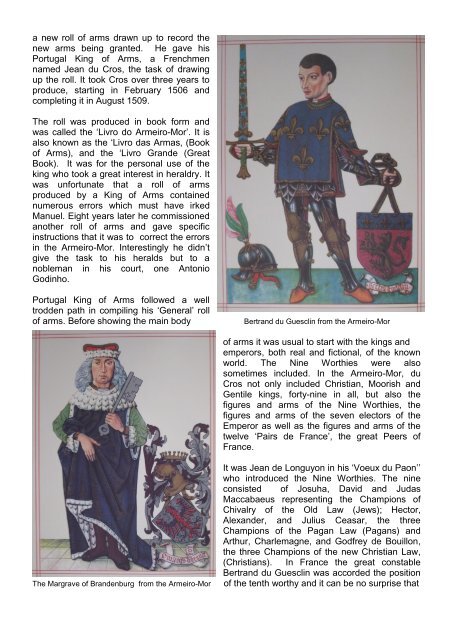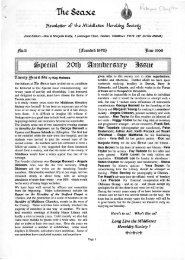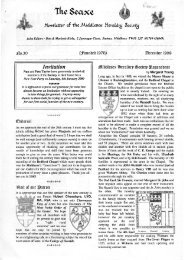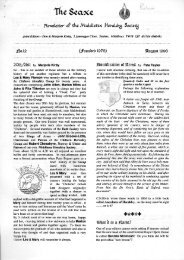No.57 - Middlesex Heraldry Society
No.57 - Middlesex Heraldry Society
No.57 - Middlesex Heraldry Society
You also want an ePaper? Increase the reach of your titles
YUMPU automatically turns print PDFs into web optimized ePapers that Google loves.
a new roll of arms drawn up to record the<br />
new arms being granted. He gave his<br />
Portugal King of Arms, a Frenchmen<br />
named Jean du Cros, the task of drawing<br />
up the roll. It took Cros over three years to<br />
produce, starting in February 1506 and<br />
completing it in August 1509.<br />
The roll was produced in book form and<br />
was called the „Livro do Armeiro-Mor‟. It is<br />
also known as the „Livro das Armas, (Book<br />
of Arms), and the „Livro Grande (Great<br />
Book). It was for the personal use of the<br />
king who took a great interest in heraldry. It<br />
was unfortunate that a roll of arms<br />
produced by a King of Arms contained<br />
numerous errors which must have irked<br />
Manuel. Eight years later he commissioned<br />
another roll of arms and gave specific<br />
instructions that it was to correct the errors<br />
in the Armeiro-Mor. Interestingly he didn‟t<br />
give the task to his heralds but to a<br />
nobleman in his court, one Antonio<br />
Godinho.<br />
Portugal King of Arms followed a well<br />
trodden path in compiling his „General‟ roll<br />
of arms. Before showing the main body Bertrand du Guesclin from the Armeiro-Mor<br />
of arms it was usual to start with the kings and<br />
emperors, both real and fictional, of the known<br />
world. The Nine Worthies were also<br />
sometimes included. In the Armeiro-Mor, du<br />
Cros not only included Christian, Moorish and<br />
Gentile kings, forty-nine in all, but also the<br />
figures and arms of the Nine Worthies, the<br />
figures and arms of the seven electors of the<br />
Emperor as well as the figures and arms of the<br />
twelve „Pairs de France‟, the great Peers of<br />
France.<br />
It was Jean de Longuyon in his „Voeux du Paon‟‟<br />
who introduced the Nine Worthies. The nine<br />
consisted of Josuha, David and Judas<br />
Maccabaeus representing the Champions of<br />
Chivalry of the Old Law (Jews); Hector,<br />
Alexander, and Julius Ceasar, the three<br />
Champions of the Pagan Law (Pagans) and<br />
Arthur, Charlemagne, and Godfrey de Bouillon,<br />
the three Champions of the new Christian Law,<br />
(Christians). In France the great constable<br />
Bertrand du Guesclin was accorded the position<br />
The Margrave of Brandenburg from the Armeiro-Mor of the tenth worthy and it can be no surprise that














